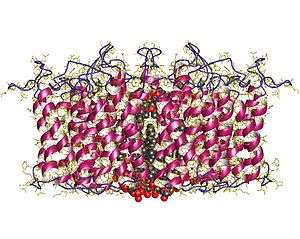Proton-gated urea channel

Urea channel hexamer (side view), Helicobacter pylori.
The proton-gated urea channel is an inner-membrane protein essential for the survival to Helicobacter pylori. It enables the rapid influx of urea into the bacterium. It is closed at pH 7.0 and fully open at pH 5.0. Urease activity buffers the periplasm to pH 6.1. Using multiwavelength anomalous dispersion (MAD), its structure, a compact hexameric ring about 95 Å in diameter and 45 A ̊ in height, was determined. The centre is filled with a lipid plug that forms an asymmetric bilayer. Amino residues that can be protonated in the periplasmic domain are important for proton sensing or gating.[1]
References
- ↑ D. Strugatsky, R. McNulty, K. Munson, C.-K. Chen, S. M. Soltis, G. Sachs & H. Luecke (2012) Structure of the proton-gated urea channel from the gastric pathogen Helicobacter pylori, Nature 493, 255–258.
This article is issued from Wikipedia - version of the 6/9/2016. The text is available under the Creative Commons Attribution/Share Alike but additional terms may apply for the media files.